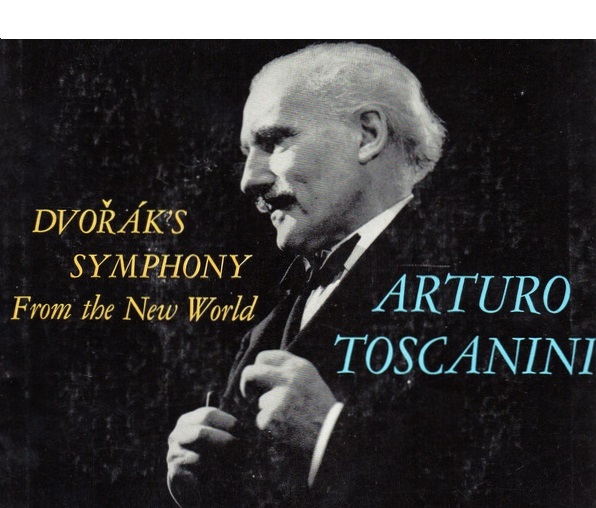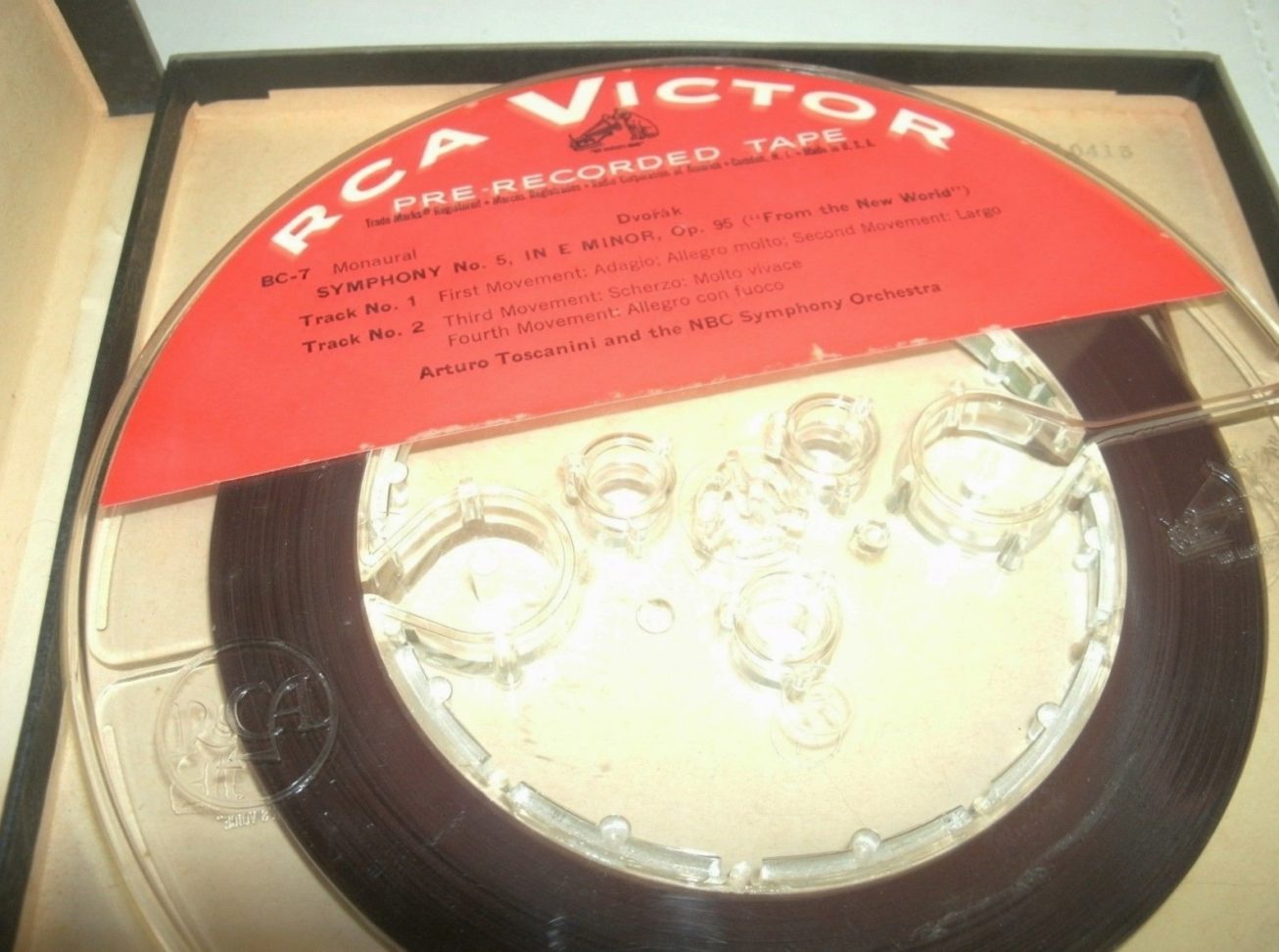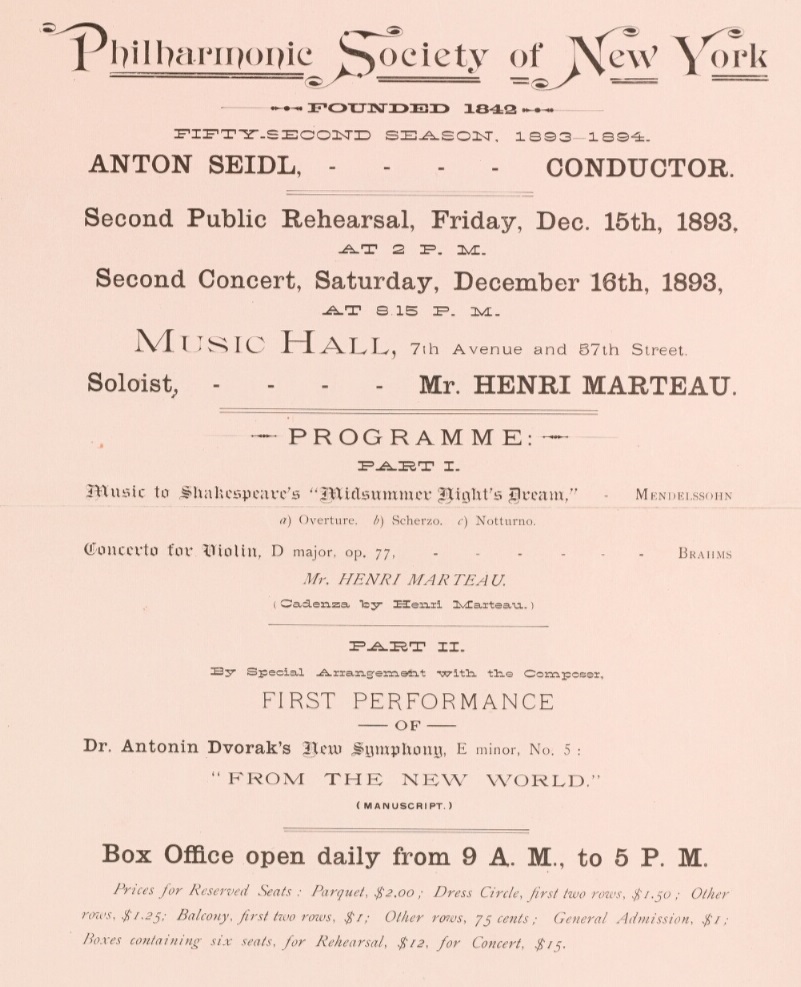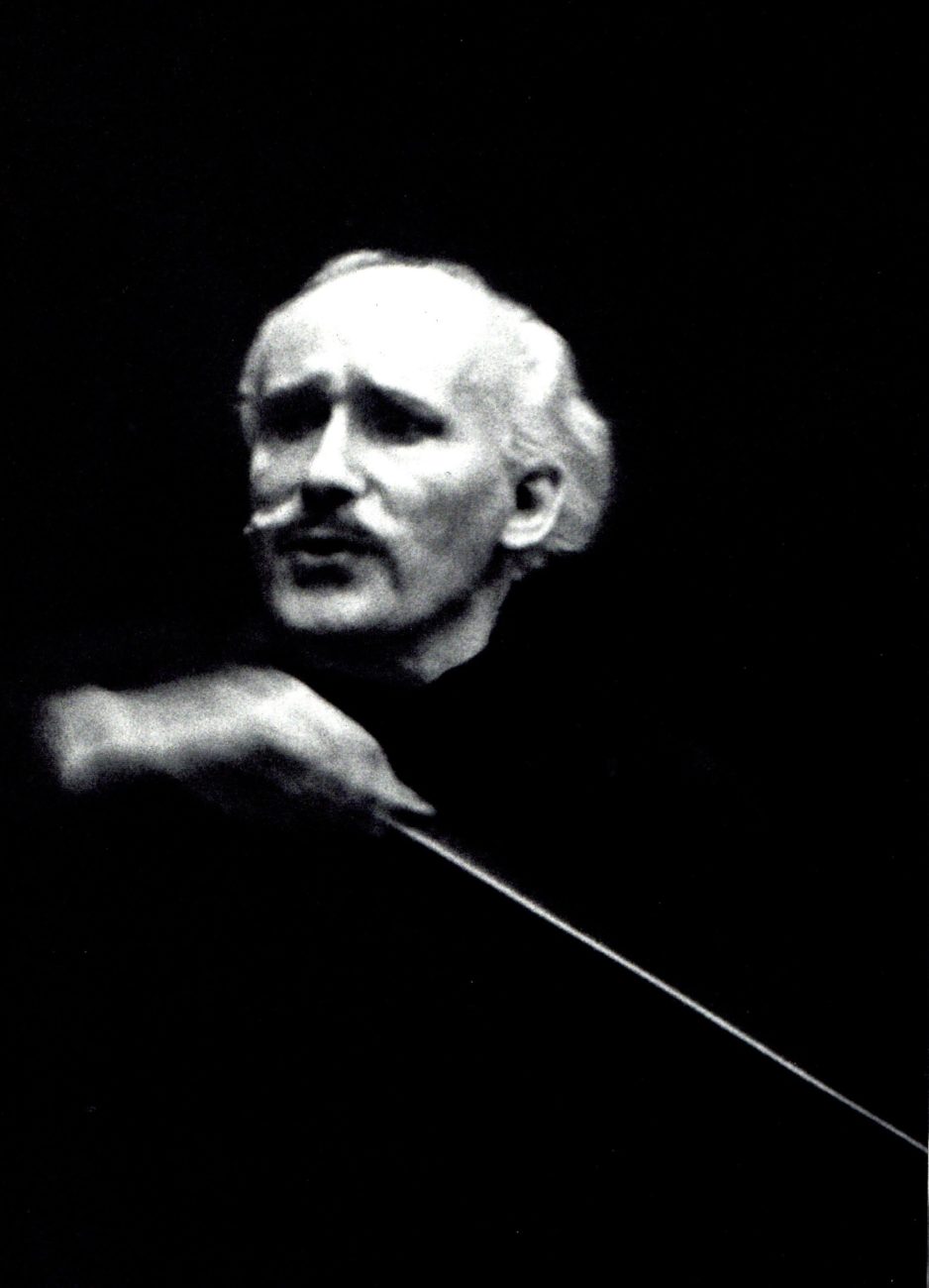Autres sites
Mon Musée Musical
The Music Parlour

Laureate conductor
Centre for the History and Analysis of Recorded Music
Big 10-inch record
Vinyl Fatigue
The Shellackophile
Historic recordings
jolyon.com

Beethoven quartet unofficial page (Site HD)


Paul Michael von Ganski's record club

Association internationale Dimitri Chostakovitch

Quartier des archives

Toscanini – III – NBC SO – Dvořák: Symphonie n°9 Op.95
- 8 commentaires sur Toscanini – III – NBC SO – Dvořák: Symphonie n°9 Op.95
- Date de l’article 9 juin 2021
- Auteur de l’article Par C&A HD
Arturo Toscanini – NBC SO
Enregistré à Carnegie Hall le 2 février 1953

Bande BC-7 (19cm/s 2 pistes) publiée en 1954

Presque 60 ans après la création de cette œuvre les 15 & 16 décembre 1893 sous la direction d’Anton Seidl (1850-1898) dans cette même salle alors dénommée « Music Hall 7th Avenue and 57th Street » avant de devenir le célèbre « Carnegie Hall », Toscanini, qui a dirigé l’oeuvre dès 1898, nous en laisse un témoignage qui reste un fleuron de ses dernières saisons à la tête du NBC Symphony Orchestra.
A partir de 1952, RCA a modifié sa technique d’enregistrement, du moins en ce qui concerne Toscanini. La captation a été réalisée avec un seul microphone positionné environ 5 mètres au dessus du chef, la même technique que celle déployée à l’époque par d’autres firmes telles que Mercury ou Westminster. Il en résulte une perspective sonore et une dynamique naturelles que l’on n’avait pas l’habitude d’entendre dans ses disques et qui sont magnifiées par l’édition sur bande (19 cm/s, 2 pistes), laquelle surclasse les publications en microsillon et en CD, en restituant des subtilités de phrasé et de rythme que l’on pensait n’exister que dans l’enregistrement du concert du 31 janvier précédant cet enregistrement.

Extrait du texte de présentation du 33t. LM-1778

Nearly 60 years after the work was premiered on December 15 & 16 1893 under the direction of Anton Seidl (1850-1898) in the same Hall then called « Music Hall 7th Avenue and 57th Street » before it came universally known as the « Carnegie Hall », Toscanini, who performed the work as early as 1898, gives us a testimony which remains one of the main highlights of his last seasons with the NBC Symphony Orchestra.
As of 1952, RCA changed its recording technique, at least as far as Toscanini was concerned. This recording was made with a single microphone placed approximately 16 feet above the conductor’s head, namely the same technique as implemented then by companies like Mercury or Westminster. This accounts for a natural sound perspective and natural dynamics seldom heard before in his recordings and that are enhanced by the tape issue (7.5 ips; 2 tracks), which outdoes the LPs and CDs, unveiling subtilities of phrasing and of rhythm that were believed to exist only in the recording of the concert given shortly before on January 31.
___________________

___________________

___________________

___________________
Les liens de téléchargement sont dans le premier commentaire. The download links are in the first comment.
- 8 commentaires sur Toscanini – III – NBC SO – Dvořák: Symphonie n°9 Op.95
- Date de l’article 9 juin 2021
- Auteur de l’article Par C&A HD
- Étiquettes Arturo Toscanini, Bande/Tape, Dvorák, NBC SO
Calendrier
mai 2024
- SCHNABEL AUSTRALIAN TOUR 1939 May 17 – August 16 – 27 Concerts – II/II
- SCHNABEL AUSTRALIAN TOUR 1939 (May 17 – August 16) – 27 Concerts – I/II
avril 2024
- Menuhin Paganini: Concertos n° 1 & 2 – Fistoulari
- Kipnis – Mozart Verdi Wagner 1916-1937
- Fischer – Philharmonia Orchestra – Beethoven: Concerto n°4 Op.58
- Menuhin Furtwängler – Mendelssohn: Concerto Op.64 BPO – Beethoven: Romances Op.40 & 50 Philharmonia Orchestra
mars 2024
- Fischer – Philharmonia Orchestra – Beethoven Concerto n°3 Op. 37
- Fischer – Salzburger Festspiele 1949 & 1951 – Enregistrements inédits / Unpublished Recordings
- Munch-IX- Ravel: Tombeau de Couperin ON – Ma Mère l’Oye La Valse BSO
- Heifetz- Bach: Concertos BWV 1041 & 1042 Wallenstein LAPO
février 2024
- Quatuor Pro Arte Schnabel – Mozart: Quintet K.516 & Quartet K.478
- Monteux – V – Brahms Symphony n°1 Op.68 BSO
- Milstein – Dvořák Concerto Op.53 Steinberg Pittsburgh SO
- Beecham – III – Schubert: Symphonie n°6 D.589 RPO
janvier 2024
- Haskil – Anda – Mozart: Concerto n°10 K.365 Philharmonia Orchestra Galliera
- Petri – Beethoven Sonate n° 23 Op. 57
- Reiner – II – Mozart: Symphonie n°41 K.551 CSO
- Munch – VIII – Berlioz: Harold en Italie Op.16 – de Pasquale BSO
- Munch – VII – Fauré: Ballade Op.19 Ravel: Concerto en sol Tzigane Rapsodie Espagnole BSO Henriot-Schweitzer Silverstein
décembre 2023
- Cantelli – XIII – Tchaïkovsky Romeo & Juliet NBC SO – Respighi I Pini di Roma NYPO
- Fine Arts Quartet – II – Mozart: Horn Quintett K.407 Barrows – Oboe Quartett K.370 Still & Quartett n°14 K.387
- Fine Arts Quartet – I – Brahms Klarinettenquintett Op. 115 Kell – Wolf Italienische Serenade
- Monteux – IV – Ravel Tombeau de Couperin – Rapsodie Espagnole – Daphnis & Chloé Suites n°1 & 2 – NYPO
novembre 2023
- Monteux – III – Berlioz Symphonie Fantastique NYPO 1959
- MARIA CALLAS: PUCCINI TOSCA AT THE GREEK NATIONAL OPERA IN 1942 AND 1943
- MARIA CALLAS: PUCCINI TOSCA A L’OPERA NATIONAL DE GRECE EN 1942 ET 1943
- BEECHAM – II – MOZART 1956: Divertimento K131 Symphonies n°29 K201 & n°31 K297
- Munch – VI – Debussy La Mer Ravel Rapsodie Espagnole La Valse BSO 1955-1956
octobre 2023
- KAPELL – II – MOZART: Sonata K330 – Concerto n°12 K414 San Francisco SO MONTEUX
- WILLIAM KAPELL CHRONOLOGICAL DISCOGRAPHY: CONCERTS & BROADCASTS
- KAPELL: AUSTRALIAN TOUR JULY 18 – OCTOBER 22, 1953 – 37 CONCERTS – III/III – TRIBUTE TO WILLIAM KAPELL
- KAPELL: AUSTRALIAN TOUR JULY 18 – OCTOBER 22, 1953 – 37 CONCERTS – II/III
- KAPELL: AUSTRALIAN TOUR JULY 18 – OCTOBER 22, 1953 – 37 CONCERTS – I/III
juin 2023
mai 2023
- Cantelli – XI – Brahms Concerto n°1 Op.15 Firkušný
- Toscanini – VI – Schubert Symphony n°9 D.944 – Philadelphia Orchestra
- Munch – V – Berlioz Debussy Ravel BSO 1965
avril 2023
- Toscanini – V – Brahms: Symphony n°4 NBC SO 1951 (Concert)
- Monteux – II – Debussy: Prélude à l’Après-midi d’un faune – 2 Nocturnes; Ravel: Rapsodie Espagnole – Pavane pour une Infante défunte – LSO
- Reiner – I – Dvořák: 5 Danses Slaves Op.46 & 72 – Brahms: 8 Danses Hongroises WPO
- Hüsch – II – Schubert: 16 Lieder Hanns-Udo Müller & Gerald Moore
mars 2023
- Tátrai Quartet – II – Haydn Quartets Op.76 n°4 – 6
- Tátrai Quartet – I – Haydn Quartets Op.76 n°1 – 3
- Furtwängler – Franck Symphonie WPO
- Furtwängler – Brahms: Symphonie n°2 London Philharmonic Orchestra
février 2023
- Fritz & Adolf Busch Rudolf Serkin – Radio Danoise/Danish Radio Copenhagen 1933-1934
- F. Busch A. Kipnis – Haydn: Schöpfung (extr) – Beethoven: Missa Solemnis Op.123 Sanctus – Symphonie n°9 Op.125 Finale – Radio Danoise/Danish Radio 1934-1935
- Jones – Mozart: Concertos pour Cor – Philadelphia Orchestra Ormandy
- Solomon – II – Beethoven Concertos n°2 Op.19 & n°4 Op.58 Cluytens
janvier 2023
- Cantelli- X – Moussorgski Tableaux d’une Exposition NYPO
- Chauvin: André Raison – Jean-François Dandrieu Orgue de La Flèche
- Stupka – Dvořák Symfonie n°8 Op.88 Česká filharmonie
- Anders – Schubert 4 Lieder: Einsamkeit D.620; Der Liedler D.209; Erwartung D.159; Auf dem Strom D.943
- Busch Quartet – III – Beethoven Quatuor n°9 Op.59 n°3
décembre 2022
- Boskovsky Ensemble – III
- Busch Quartet – II – Beethoven Quatuor n°8 Op.59 n°2
- Busch Quartet – I – Beethoven: Quatuor n°7 Op.59 n°1 Haydn: Quatuor Op.103
- Furtwängler Bach Brandenburgische Konzerte n° 3 BWV 1048 & 5 BWV 1050 WPO
- Cantelli – IX- Mozart: Concerto n°20 K.466 – Beethoven: Concerto n°1 Op.15 – Serkin NYPO
novembre 2022
- Bach Concertos pour Violon BWV 1041-1043 – Adolf Busch Busch Chamber Players Frances Magnes (BWV 1043)
- Cantelli – VIII – Mozart: Concerto n°21 K.467 – Gieseking NYPO
- Dvořák Sérénades Op.22: Solistes de Prague Talich – Op.44: Professorum Conservatorii Pragensis Societas Camerialis
- Ferrier – Brahms Alt-Rhapsodie Op.53 F. Busch – Mahler Kindertotenlieder Walter
octobre 2022
- Wiener Oktett – Schubert Oktett D. 803 (1954)
- West – Schubert: 15 Lieder Taubman piano
- Edwin Fischer: Concert Mozart au Palais des Fêtes de Strasbourg (Festival de Strasbourg 1953)
- Münchinger – VI – Haydn: Symphonies n°83 & n°100 WPO
- Schnabel – XI – Schumann: Quintette Op.44 (Quatuor Pro Arte) – Concerto Op.54 (LAPO Wallenstein)
- Toscanini – IV – Beethoven: Symphony n°6 Op.68 – NBC SO 1954
septembre 2022
- Shaw – Brahms: Liebesliederwalzer Op. 52 & 65 The Robert Shaw Chorale Claude Frank & Lilian Kallir, pianos
- Munch – IV – Berg: Violinkonzert Stern BSO
- Walter – V – Mahler: Das Lied von der Erde WPO Kullman Thorborg
- Münchinger – V – Haydn: Symphonies n° 96 & n°104 – WPO
août 2022
- Ančerl – II – Smetana Ma Vlast IV – VI (Z českých luhů a hájů, Tábor, Blanik) BSO
- Hüsch – I – Schubert: Die schöne Müllerin Hanns-Udo Müller
- Munch – III – Franck Symphonie en ré mineur BSO
juillet 2022
- Gui – Schubert Rossini Brahms Massenet Orchestra del Maggio Musicale Fiorentino 1953 Stereo
- Goldberg – Haydn: Symphonies n° 44 & 57 Nederlands Kamerorkest (Netherlands Chamber Orchestra)
- Melchior & Traubel Wagner: Lohengrin & Tristan und Isolde – Ormandy Hollywood Bowl
juin 2022
- Ančerl – I – Gluck Iphigénie en Aulide Ouverture – Dvořák Symphonie n°8 Op.88 Smetana Ma Vlast (Vysehrad, Vltava, Sarka) BSO
- Wiener Oktett – Mozart Divertimento n°15 K.287 (1955 Mono)
- Munch – II – Roussel: Symphonies n°3 Op.42 & n°4 Op.53 Bacchus & Ariane Suite n°2 BSO
- Fritz Busch – II- Mozart: Serenade « Haffner » K250 Sinfonie-Orchester Winterthur, Peter Rybar, Violine
- Désormière – Debussy Ravel Orchestre Philharmonique Tchèque (Česká filharmonie)
mai 2022
- Forrester – IV – Bach Kantaten BWV 53 – 54 & 169 Janigro
- Furtwängler – II – Beethoven Symphonie n°4 Op.60 – WPO 1950
- Walter – IV – Mahler Symphonie n°9 WPO
- Walter – III – Mozart Symphonies n°38 & 41 WPO – Sinfonia Concertante K.364 NYPO John Corigliano & William Lincer
avril 2022
- Schnabel – Beethoven Sonates- VII/VII – Sonates n°9 Op.14 n°1 – n°7 Op.10 n°3 – n°25 Op.79 – n°24 Op.78 – n°32 Op.111
- Schnabel – Beethoven Sonates – VI/VII – Sonates n°13 Op.27 n°1 – n°21 Op.53 – n°20 Op.49 n°2 – n°30 Op.109
- Schnabel – Beethoven Sonates – V/VII – Sonates n°4 Op.7 – n°14 Op.27 n°2 – n°10 Op.14 n°2 – n°29 Op.106
- Schnabel – Beethoven Sonates – IV/VII – Sonates n°12 Op.26 – n°17 Op.31 n°2 – n°5 Op.10 n°1 – n°6 Op.10 n°2 – n°26 Op.81a
mars 2022
- Schnabel – Beethoven Sonates – III/VII -Sonates n°2 Op.2 n°2 – n°23 Op.57 – n°19 Op.49 n°1 – n°27 Op.90 & n°11 Op.22
- Schnabel – Beethoven Sonates – II/VII – n° 18 Op.31 n°3 – n°28 Op.101 – n°22 Op.54 – n°8 Op.13 & n°3 Op.2 n° 3
- Schnabel – Beethoven Sonates – I/VII – n° 15 Op.28 – n°31 Op.110 – n°1 Op.2 n°1 & n°16 Op.31 n°1
- Heynis – Bach Händel Wiener Symphoniker – Gillesberger
- Cantelli – VII – Brahms: Tragische Ouverture Op.81 – Symphonie n°1 Op.68 – Alt Rhapsodie Op.53 -Verdi: Te Deum
février 2022
- Oïstrakh Beethoven – I – Sonates violon-piano n° 1, 3, 4 & 5 Yampolsky Goldenweiser Oborin
- Cantelli – VI – Brahms: Symphonie n°3 Op.90 – 2 Versions
- Chapuis – Maîtres Français de l’Orgue – Orgue Clicquot de la Cathédrale de Poitiers
janvier 2022
- Scherchen – II – Mahler: Symphonie n°7 Toronto SO
- Furtwängler – Beethoven: Symphonie n°9 Op125 Bayreuther Festspiele Bayerischer Rundfunk 29 Juli 1951 – BIS Edition SACD & Téléchargement
- Münchinger – IV – Mozart: Concerto pour Clarinette K622 (Alfred Prinz) & pour Flûte et Harpe K299 (Werner Tripp & Hubert Jelinek) WPO
- Cantelli – V – Ouvertures: Rossini ( Il Signor Bruschino; Cenerentola; Semiramide), Verdi (La Forza del Destino) & Wagner (Faust-Ouvertüre)
décembre 2021
- Boskovsky Ensemble – II
- Günther Ramin & Karl Straube – Paris 1938
- Fischer – II – Schubert: Wanderer Fantasie D.760 Moments Musicaux D.780
- Cantelli – IV – Schumann: Symphony n°4 Op. 120 – 2 Versions Philharmonia 1953 – NYPO 1956
- Panzéra – Fauré: Mélodies M. Panzéra-Baillot
novembre 2021
- Walter – II – Mahler: Symphonie n°4 – NYPO – Seefried
- Flagstad 1950-1951 – Wagner: Wesendonck Lieder Øivin Fjeldstad – Grieg: Haugtussa Op.67 Edwin Mc Arthur
- Mitropoulos – The Complete RCA and Columbia Album Collection (Sony Classical)
- Mitropoulos – VIII – Mahler: Sinfonie n°3 – Kölner Rundfunk SO – Lucretia West, mezzo-soprano
- Schnabel – III – Beethoven: Variations « Diabelli » Op.120 & « Eroïca » Op.35
octobre 2021
- Forrester – III – Mahler: Kindertotenlieder – Lieder eines fahrenden Gesellen – Munch BSO
- Mitropoulos – VII – Mozart: Concertos n°16 K.451 & n°25 K.503 Serkin NYPO
- Quatuor Beethoven – VI – Beethoven: Quatuors n°4 Op.18 n°4, n°10 Op.74 ‘Les Harpes’ & n°16 Op.135
- Mitropoulos- VI – Berlioz: Symphonie Fantastique NYPO
septembre 2021
- Schnabel – II – Schubert: « Forellenquintett » D667 Membres du Quatuor Pro Arte & Claude Hobday
- Walter – I – Mahler: Symphonie n°1 – New-York Philharmonic
- Fischer-Dieskau – Brahms: Lieder und Gesänge Op.32 Klust – Mahler: Lieder eines fahrenden Gesellen Philharmonia Orchestra Furtwängler
- Münchinger – Schubert III/III Symphonies n° 6 & 8 WPO
- Schnabel – I – Beethoven: Bagatellen Op. 33 & 126 – Fantasia Op.77 – 3 Rondos
août 2021
- Münchinger – Schubert II/III Symphonies n° 4 & 5 WPO
- Stratas Récital à Moscou le 22 juillet 1963
- Münchinger – Schubert I/III: Symphonies n° 2 & 3 WPO
- Dreyfus – J-S Bach: Toccatas pour clavecin BWV 913, 914, 910 & 911
juillet 2021
- Richter – Liszt: Sonate en si mineur S178
- Igor & David Oïstrakh Rudolf Barshaï – Mozart: Duos K423 & 424 – Sinfonia Concertante K364
- Coffret Warner 55 CD: « The Complete Wilhelm Furtwängler on Record »
- Mitropoulos – V – Brahms: Concerto n°2 en si bémol majeur Op. 83 – Rudolf Serkin – NYPO
juin 2021
- Quatuor Philharmonique de Moscou – Mozart: Quatuors n°17 K458 – n°19 K465 – n°1 avec flûte K285
- Mitropoulos – IV – Brahms: Concerto n°1 en ré mineur Op.15 – William Kapell – NYPO
- Goldenweiser – Mozart: Quatuors avec piano n°1 K.478 (Membres du Quatuor Komitas) et n°2 K.493 (Membres du Quatuor Philharmonique de Moscou)
- Toscanini – III – NBC SO – Dvořák: Symphonie n°9 Op.95
- Quatuor Beethoven – V – Mozart: Quintette K516 M.Terian
mai 2021
- Mitropoulos – III – Mendelssohn: Symphonie n°3 Op. 56 – Minneapolis SO
- Neuhaus – Beethoven: Musique de Chambre: Quatuor WoO36 n°2 – Trio Op.97 – Sonate violon piano Op.47 – I
- Scherchen – Forrester – Bach: Kantaten BWV 42 & 35
- Blech – IIIa – Beethoven avec Fritz Kreisler
- Tamarkina – I – Brahms Quintette Op.34 Quatuor du Théâtre Bolshoï
avril 2021
- Blech – III – Beethoven & Brahms avec Fritz Kreisler
- Mitropoulos – II – Tchaïkovsky Symphonie n°6 Op.74 – NYPO
- Fischer – Philharmonia Orchestra – Beethoven Concerto pour piano n°3 Op. 37
- Blech -II- Mendelssohn avec Fritz Kreisler
mars 2021
- Pierre Cochereau – César Franck – Trois Pièces (1878) – Huit Pièces extraites de L’Organiste – Orgue de Notre-Dame de Paris (1958)
- Bashkirov – Brahms Sonate n°3 Op.5 – Quatuor avec piano n°3 Op.60 Membres du Quatuor Borodine
- Solomon – I – Philharmonia Orchestra Herbert Menges – Beethoven Concerto n°5 Op.73
- Mogens Wöldike – Haydn Symphonies n° 100 « Militaire » & 101 « L’ Horloge »
- Furtwängler – Bruckner Symphonie n°4 – Welche Fassung? Quelle Version?
- Quatuor Beethoven – III – Beethoven Quatuors n°2 Op.18 n°2 & n°13 Op. 130
février 2021
- Bernard Kruysen et Jean-Charles Richard – II– Schumann Dichterliebe Op.48 & Romanzen und Balladen Op.53
- Mitropoulos – I – Franck Symphonie en ré mineur
- Monteux – I – Berlioz Roméo et Juliette
- Furtwängler – Un enregistrement inédit de l’ « Inachevée » de Schubert – WPO Copenhagen – 1er Octobre 1950
- Mahler – Des Knaben Wunderhorn – Maureen Forrester Heinz Rehfuss – WSO Felix Prohaska
janvier 2021
- Blech- I – Staatskapelle Berlin – Divers 1926-1930
- Quatuor Beethoven – II – Schubert Quatuors D173 & D810
- Cantelli – III – Verdi Requiem
- Emil Guilels – Membres du Quatuor Beethoven – Brahms Quatuor avec piano Op. 25 (enregistré en 1947)
- Beethoven Intégrale des symphonies 1926 – 1950
décembre 2020
- Furtwängler – Beethoven Symphonie n°5 – Wiener Philharmoniker (WPO) Copenhagen 1er octobre 1950
- Boskovsky Ensemble – I
- Cantelli – II – Haydn & Mozart
- Beethoven Symphonie n°2 – Sir Thomas Beecham – London Philharmonic Orchestra (LPO) 1936
- Günther Ramin – I – Bach Weihnachts-Oratorium – Kantate 1-3 (STEREO)
- Weingartner – Beethoven Symphonie n° 9 (1926)
novembre 2020
- Haskil – I – Beethoven Concerto n°4 Op. 58 Orchestra Sinfonica di Torino della RAI – Rossi
- Cantelli – I – Debussy: La Mer – Le Martyre de Saint-Sébastien (fragments symphoniques)
- Toscanini BBC SO – II – Beethoven Symphonies n°1 & 6
- Toscanini BBC SO – I – Beethoven Symphonies n°7 & 4
- Bernard Kruysen et Jean-Charles Richard – I – Schumann Liederkreis Op. 39 & Gedichte Op. 90
- Fritz Busch – I – Beethoven Symphonies n° 3 et 8
- Bienvenue sur le site Concerts & Archives HD
Autres sites
Mon Musée Musical
The Music Parlour

Laureate conductor
Centre for the History and Analysis of Recorded Music
Big 10-inch record
Vinyl Fatigue
The Shellackophile
Historic recordings
jolyon.com

Beethoven quartet unofficial page (Site HD)


Paul Michael von Ganski's record club

Association internationale Dimitri Chostakovitch

8 réponses sur « Toscanini – III – NBC SO – Dvořák: Symphonie n°9 Op.95 »
HD/Hi-Res (24 bits/88 KHz):
https://e.pcloud.com/publink/show?code=kZc2hVZnCqcogJBRYV5eMdk8Yr75p2weTP7
Format CD (16 bits/44 KHz):
https://e.pcloud.com/publink/show?code=kZC6hVZrzBxQLFzXaygqHgzE2RNw02kJo4k
I am a great admirer of Toscanini’s performances, especially with the incredible NBC Symphony Orchestra, but dare I say it I found the performance here a little severe?! This uncompromising interpretation however is in itself a wonder because of the conviction it carries & the electricity of the playing.
Most importantly for this thread I must say what an absolutely stunning sound you have presented for us with that tape…rarely have I heard such an exciting, clear sound from recordings of this orchestra…if I shut my eyes & listen I’m sitting in Carnegie Hall on the 3rd of February 1953!
Thanks so much for posting this recording!!
in fact, the January 31th public performance is somehow more flexible. Conversely, the sound is no so warm, because the acoustics of the Hall is a bit dry in comparison with that of the empty Hall. i’ll have to think about posting that performance, too.
Funnily enough I DO have that live 31/01 performance on a cheap CD but the sound is not so good (maybe the source or the transfer?). I just had a quick listen to that, yes maybe it is a little more flexible, dryer because of the audience padding the hall & maybe the engineers miking closer to avoid audience noise (although there are some spectacular coughs at the start!)?.
Your tape does really sound super, great balances (almost a stereo spread too), really punchy sound (those timpani are incredible). Thanks again.
This is the magic of mono sound with one well placed single microphone!
The files are one-track, pure mono, the acoustics of the hall and the sense of space are there, no need to add anything such as « Ambient Stereo » or the like that severely damp the sound.
The Kubelik-Chicago SO recording of this work (1951) was done by Mercury with one microphone and exactly the same placement.
I have other Toscanini tapes commercially issued by RCA, but this is the only one (issued in 1954!) that sounds almost pristine throughout.
Thank You for this amazing recording.
I discovered this symphony decades ago thanks to this electrifying version and was surprised that , despite recorded in mono, we could hear so many details. Thank you so much for your beautiful transfer, even better to my old RCA Lp.
Like Nikos, I have the live performance on a Virtuoso CD, with >I>Pictures at an Exhibition from the previous week’s concert. Thank you for a chance to hear your transfer, which should be closer to the original tape. It certainly sounds marvelous.